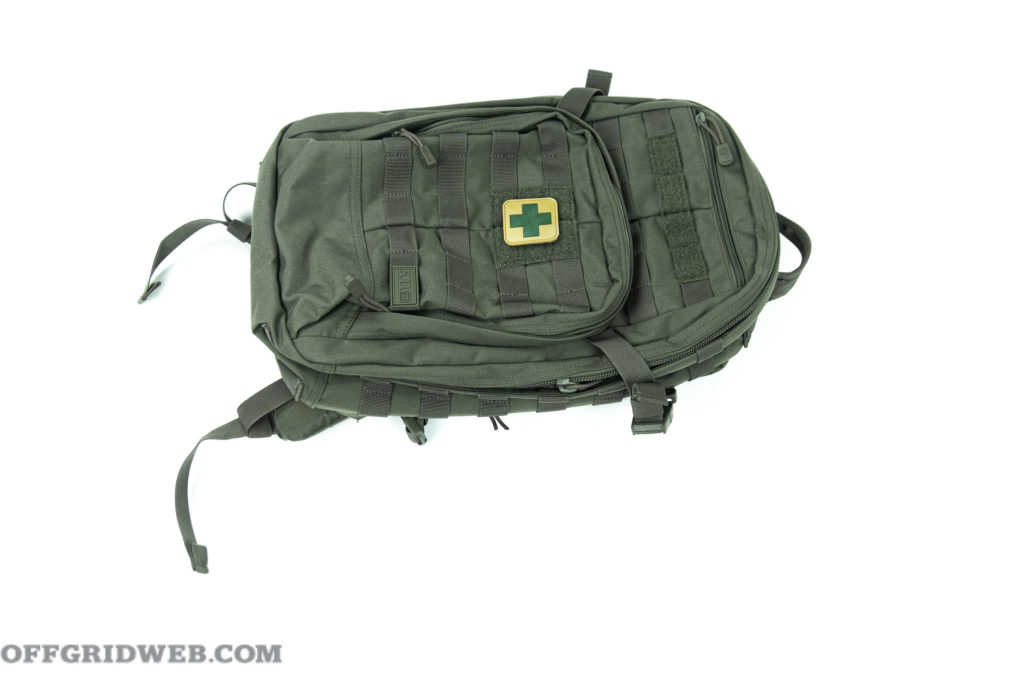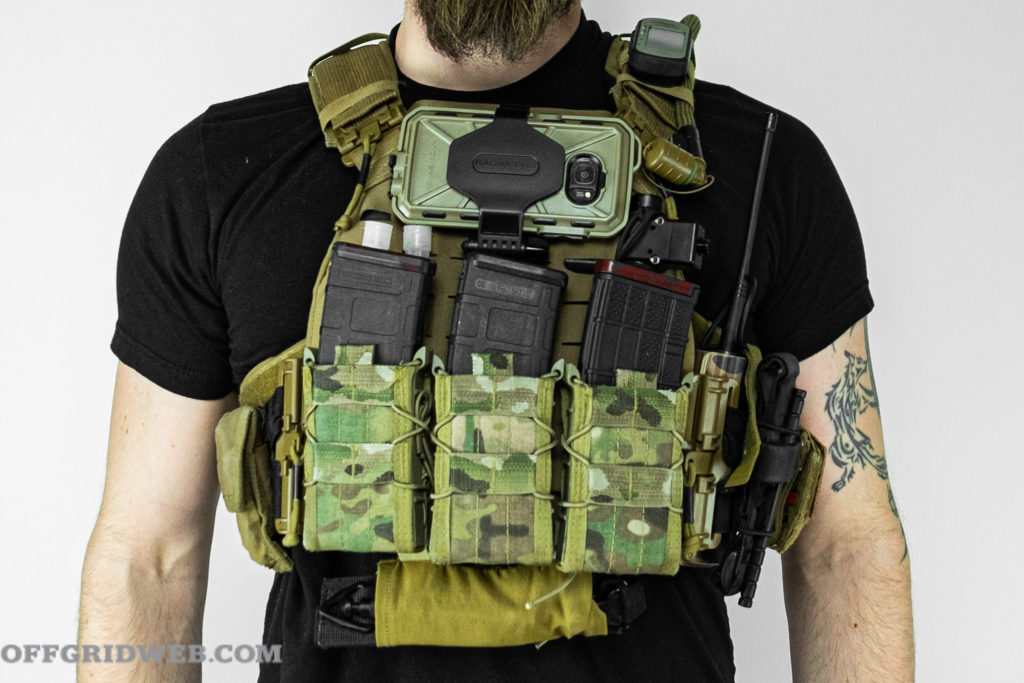Battlefield medicine has made leaps and bounds through improved infrastructure and a near-universal deployment of the IFAK or Individual First Aid Kit. As a result some lessons can be taken when considering both the rising civil unrest in cities like Minneapolis, as well as remaining prepared during more peaceful times. By taking an approach similar to our article on Layering Your EDC Survival Gear, we can divide our Medical Gear into four layers: Personal EDC, Kit-Mounted, Vehicle-borne, and Home base.
Foundational Considerations
Considering that most of us don’t have the same medical infrastructure as the military or a hospital’s resources at our disposal, we must take elements of what they have taught us, and apply it in the context of our daily lives. Similar to our article on the Tactical and Survival Application of Body Armor, we began by recognizing that Plate Carriers are for a world with Hospitals. Access to a medical facility will have an influence on how we set up each layer of medical preparedness.

In our modern environment, what separates an emergency kit from long-term sustainment is access to professional medical treatment. We may be able to prevent a gunshot wound from becoming fatal, but our objective will still be to get the wounded to a hospital. If there is no access to medical facilities, the situation is much more dire. However, we can begin from the known and expand further.
In a past life, Ranger First Responder training taught the acronym M.A.R.C.H. Each letter stood for a different type of injury, and established a hierarchy of greatest immediate threat, descending to long-term care. Broken down, M.A.R.C.H. stood for:
M: Massive Hemoraging/Bleeding
A: Airway
R: Respiratory
C: Circulation
H: Head Trauma/Heat Injury
This acronym is one of many used for emergency medical responses, and the importance of training cannot be overstated. Without spending time with these tools in your hands, their value is greatly diminished, and in the brief moments when an emergency medical response is needed, the additional confidence and skill impact more than the possibilities of life and death, but the emotional aftermath.

The important element to take away from M.A.R.C.H. today is that they represent different types of life-threatening injuries where time is of the essence. While we can leave the order of treatment to another time, we can address what different levels of an IFAK should, and could contain.
Personal, Kit, Vehicle, Home
The four categories we’ve chosen: Personal EDC, Kit-Mounted, Vehicle-borne, and Home can integrate into one another, are best thought of as a physical representation of a Venn Diagram: their contents overlap often, with each tailored toward a situationally specific direction.
Personal EDC
Two elements dictate what and someone’s Personal EDC will contain: what they need, and what they’re comfortable carrying. Needs are a given and typically prescribed by a doctor. Comfort, however, is where one must seriously pick and choose, as the primary limitation of EDC gear is space.
With all the attention paid to defensive tools such as knives and handguns, it’s natural that we turn to medical gear as a close second. A tourniquet handy can quickly save a life, from witnessing a motorcycle wreck to an active shooter, to improvising a splint in the wilderness, it has more uses than simply stopping major bleeding.
A TQ can be easily kept in a bag, carried in a pocket, or stored in a holder. However as not all wardrobes will facilitate these options, a serious consideration of fitting into one’s environment comes into play. Dressing for galas is rarely a daily occurrence, and the homeless look works in some urban environments, but little stands out more than a person trying too hard to conceal something that they should have kept off-body.
Various EDC medical kits have tried to remedy this: from self-contained wallet-sized packages, to ankle kits, and a few more. Ultimately it is up to the individual to make the choice about what they carry and pay the consequences for it.
Kit-Mounted
Inspired by the Military, adding an Individual First Aid Kit to one’s plate carrier or shooting belt separates itself from their personal EDC in both tone and focus. Since it is connected to firearm-related gear, whether for practice or for protection, the focus of this IFAK is for conflict-induced injuries. This is the place to focus on gunshot wounds and lacerations.
Massive Hemoraging: Tourniquets, Pressure Dressings, Gauze Bandages, and Clotting Agent.
Airway: Nasopharyngeal Airway
Respiratory: Chest Seals of some type. Only carry a Decompression Needle if trained in its use.
Circulation: While Combat Medics will likely be concerned with maintaining enough blood pressure to keep the blood flowing during an emergency, this is the opportunity to cover smaller wounds. Consider the value of carrying an IV starter kit without maintaining access to IV solution.
Head Trauma and Heat Injury: For those in cold climates, a micro space blanket will go a long way in the event of injury.
Additional Considerations: Non-Latex Gloves, a CPR Mask, combat shears, additional tourniquets, disinfectant, over-the-counter pain killers, sharpie and laminated card to write details on.

A little goes a long way when it comes to kit-mounted medical gear. The primary focus of an IFAK is to meet the needs of the wearer. Whether for self-care or to treat another person, the objective is in the title: Individual First Aid Kit.
At least annual maintenance should be performed on a belt-mounted IFAK. Whether it rarely sees use, or if the range is a frequent occasion, the contents will degrade over time. Set a date, and stick to it.
Vehicle-borne
A vehicle-borne portable medical kit is built primarily for a mass casualty situation, where multiple people might need treatment, with the possibility that some might need transportation to a hospital. According to military terms, mass-casualty typically refers to when at least 10% of the force is killed or wounded, but for survival and private citizen considerations, it informs a vehicle kit to focus on treating more than one person.

With special considerations for things like car accidents, a vehicle-portable medical kit will contain many of the same things as an IFAK. However, it should be understood as more than just a larger version of a personal medical kit. Seasonal appropriate inclusions, like winter clothes, or regional necessities, such as additional water define the focus of this kind of kit.
Larger fanny-pack or sling bag style bags such as the Tactical Tailor First Responder Bag easily store in a vehicle, taking up little enough space to have a dedicated location.
Home Base
If this type of portable medical kit could have another name, it would call itself family emergency first aid. Heavily dependent on the number of people in your household, the political and natural environment, and the emergency plans one has in place, the largest of options doesn’t need to be as portable, so long as it’s purpose is pre-determined. Is your family planning on bugging out in the event of an emergency? Do you live in a condo or a single-family home?

For those who live alone, the home kit should be the place where backup supplies are stored. That way, what doesn’t make it into the IFAK can be kept in a centralized location, and serve as a resupply opportunity if something gets damaged or used. As its purpose is to treat emergencies, not everyday cuts and bruises, it should be kept separate than a household first-aid kit. There’s nothing against keeping bandages in both the bathroom and the bug-out kit, but it would be a tragedy if the emergency supplies were raided and not replenished before an unexpected tragedy.
A spare backpack can easily accomplish the needs of family kit. The items in this kit prioritize long-term storage, and should have a dedicated storage location in the house: a coat closet by the front door, or hanging from a door to the basement.
The size of the bag comes down to personal preference and what training family members have received.
Putting It All Together
We began this article on portable medical kits with the understanding that we will not have the infrastructure and supply line capabilities of a hospital or military unit. That spirit continues in not only how one layers their IFAK with other medical gear, but also how they go about acquiring it. With companies like North American Rescue, Guerilla Tactical, and Live the Creed providing full medical kits for what might go on your battle belt, plate carrier, or chest rig, the best approach to the next layers: vehicle-borne, and home base supply, is to remain methodical.
For example, a single pack can serve as both the vehicle portable medical kit and home base supply, doubling duties by having a designated storage location in a vehicle that is typically parked, unlocked, in an attached garage. Folded Gauze, pressure dressings, and tourniquets are often sold in packs, ready to be distributed across a growing system.
The primary objective of layering emergency medical quipment is to be able to scale one’s response to a changing scenario. Since it is impossible to create a single kit that works for every situation, each step up: from IFAK to Vehicle Kit, recognizes the known and likely hazards that one could face. By tailoring each layer to the known and likely scenarios one could face, they improve their position at each level.
Gear Shown
Blue Force Gear Micro Trauma Kit NOW!
Colors: Black, Coyote Brown, OD Green, Wolf Grey, Multicam
Option To Come Stocked? Yes
MSRP: $73 Empty, $110 with Essentials Kit, $140 with Pro Kit, $200 with Advanced Kit
URL: www.blueforcegear.com
Esstac DST Medical Pouch
Colors: Black, Ranger Green, Coyote Brown, Wolf Grey, Tan 499, OD Green, Kryptek Typhoon, Kryptek Highlander, Multicam, Multicam Black, Multicam Tropic, Multicam Arid, M81 Woodland, Woodland Marshal, Desert Marshal
Option To Come Stocked? No
MSRP: $50
URL: esstac.com
Tactical Tailor First Responder Bag
Colors: Black, OD Green, Ranger Green, Coyote Brown, Multicam
Option To Come Stocked? No
MSRP: $110
URL: tacticaltailor.com
5.11 Tactical Rush12 2.0 Backpack
Colors: Black, Grey, Tan, Ranger Green
MSRP: $100
URL: 511tactical.com
Ferro Concepts x Forward Observations Roll 1
Colors: Multicam, Ragnar Green, Black, Tan, Wolf Grey
MSRP: $85
URL: www.forwardobservations.com
More on Emergency Life Saving Gear
- 2019’s list of CoTCCC-approved tourniquets.
- Pocket Preps: CPR Masks
- Pocket Preps: Individual First Aid Kits.
Related Posts
The post IFAK vs Portable Medical Kit: Scaling Medical Gear appeared first on RECOIL OFFGRID.












